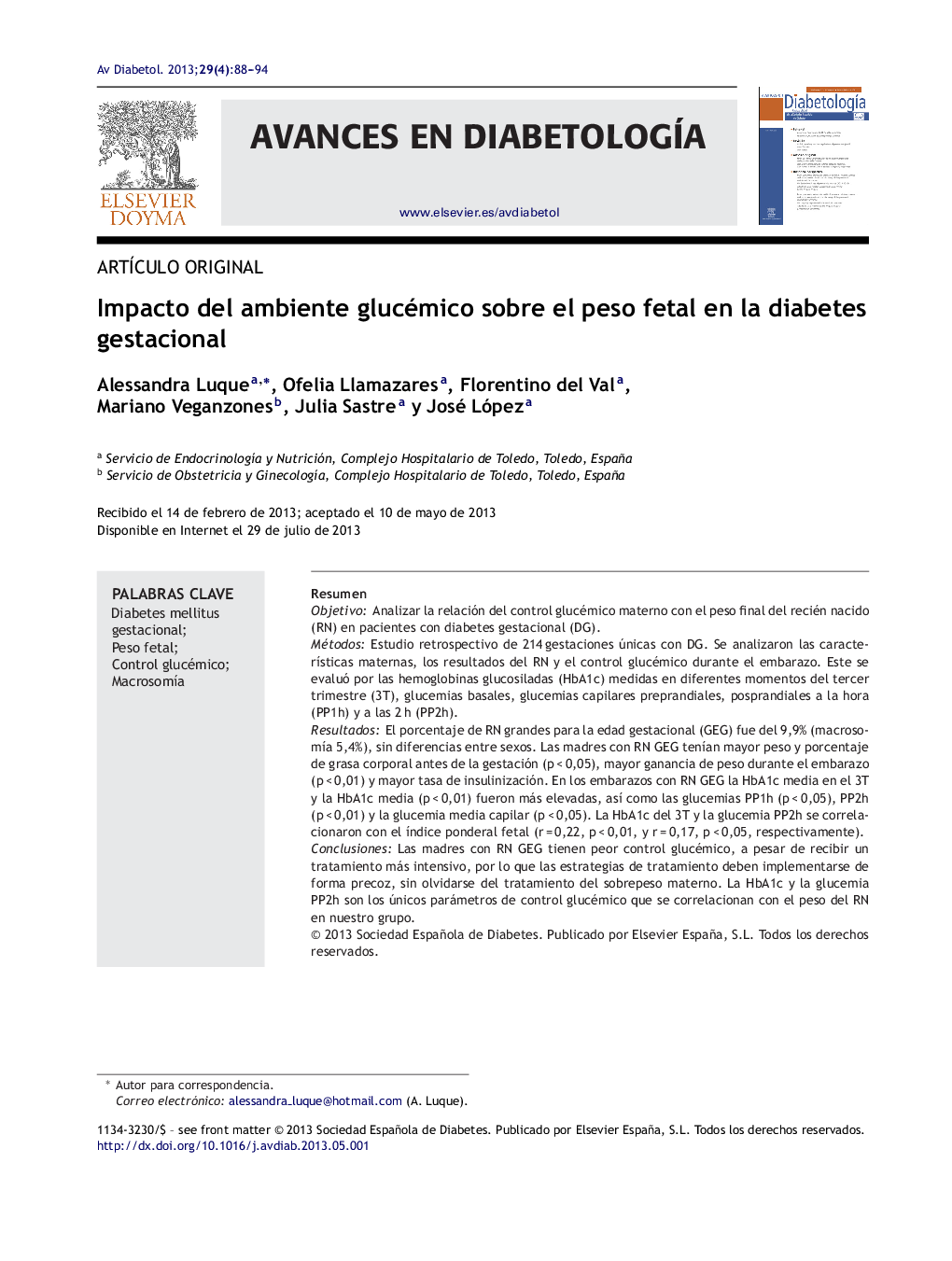| کد مقاله | کد نشریه | سال انتشار | مقاله انگلیسی | نسخه تمام متن |
|---|---|---|---|---|
| 3253637 | 1207139 | 2013 | 7 صفحه PDF | دانلود رایگان |

ResumenObjetivoAnalizar la relación del control glucémico materno con el peso final del recién nacido (RN) en pacientes con diabetes gestacional (DG).MétodosEstudio retrospectivo de 214 gestaciones únicas con DG. Se analizaron las características maternas, los resultados del RN y el control glucémico durante el embarazo. Este se evaluó por las hemoglobinas glucosiladas (HbA1c) medidas en diferentes momentos del tercer trimestre (3T), glucemias basales, glucemias capilares preprandiales, posprandiales a la hora (PP1h) y a las 2 h (PP2h).ResultadosEl porcentaje de RN grandes para la edad gestacional (GEG) fue del 9,9% (macrosomía 5,4%), sin diferencias entre sexos. Las madres con RN GEG tenían mayor peso y porcentaje de grasa corporal antes de la gestación (p < 0,05), mayor ganancia de peso durante el embarazo (p < 0,01) y mayor tasa de insulinización. En los embarazos con RN GEG la HbA1c media en el 3T y la HbA1c media (p < 0,01) fueron más elevadas, así como las glucemias PP1h (p < 0,05), PP2h (p < 0,01) y la glucemia media capilar (p < 0,05). La HbA1c del 3T y la glucemia PP2h se correlacionaron con el índice ponderal fetal (r = 0,22, p < 0,01, y r = 0,17, p < 0,05, respectivamente).ConclusionesLas madres con RN GEG tienen peor control glucémico, a pesar de recibir un tratamiento más intensivo, por lo que las estrategias de tratamiento deben implementarse de forma precoz, sin olvidarse del tratamiento del sobrepeso materno. La HbA1c y la glucemia PP2h son los únicos parámetros de control glucémico que se correlacionan con el peso del RN en nuestro grupo.
ObjectiveTo assess the relationship between maternal glycaemic control and final newborn (NB) birth weight in patients with gestational diabetes (GD).MethodsA retrospective study was conducted on 214 singleton pregnancies with GD. Maternal characteristics, newborn outcomes and glycaemic control during pregnancy were analysed. GD was assessed by measurements of glycated haemoglobin (HbA1c) at different times during the third trimester (3T), fasting, pre-prandial, and 1 and 2 hour post-prandial capillary blood glucose (1hPP-2hPP).ResultsThe percentage of NB large for gestational age (LGA) was 9.9% (macrosomia 5.4%), with no differences between genders. Mothers with LGA NB had a higher weight and percentage of body fat before pregnancy (P < .05), more weight gain during pregnancy (P < .01), and required more insulin. In pregnancies with LGA NB, the mean third trimester HbA1c and mean HbA1c (P < .01), were higher, as well as 1hPP (P < .05), 2hPP (P < .01) blood glucose and mean capillary blood glucose (P < .05). The mean third trimester HbA1c and 2hPP blood glucoses were correlated with the fetal weight index (r = 0.22, P < .01, and r = 0.17, P < .05, respectively).ConclusionsMothers with LGA NB have worse glycaemic control, despite having received a more intensive treatment. Treatment strategies should be implemented early during pregnancy, not forgetting maternal overweight treatment. HbA1c and 2hPP blood glucose are the only control parameters that correlated with NB weight in our group.
Journal: Avances en Diabetología - Volume 29, Issue 4, July–August 2013, Pages 88–94